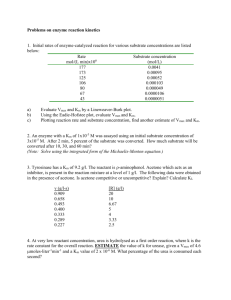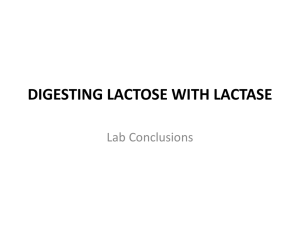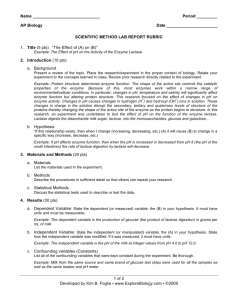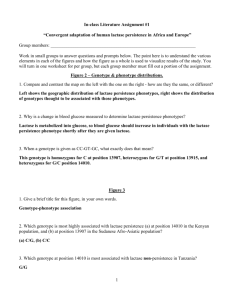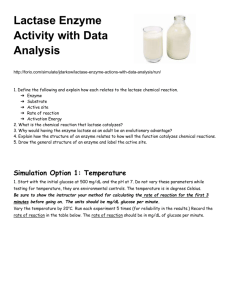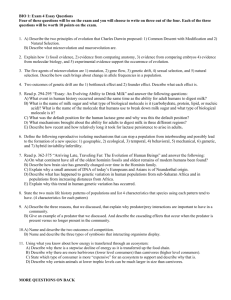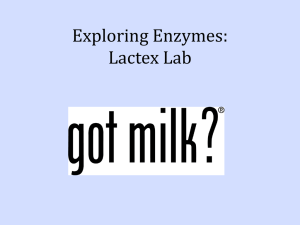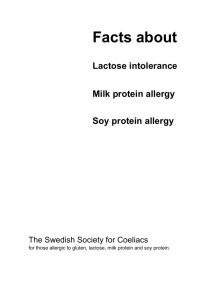Natural Selection and Adaptation
advertisement
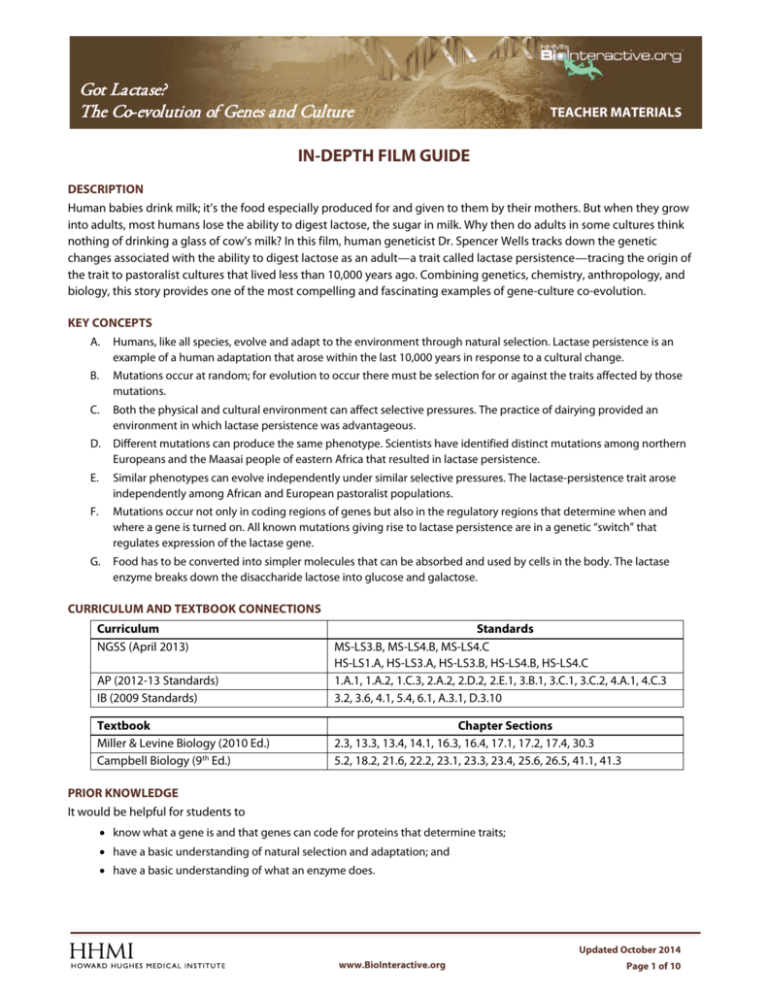
The Making of the Fittest: Lactase? TheGot Making of the Fittest: Natural Selection and Adaptation The Co-evolution of and Culture Natural Selection and Genes Adaptation TEACHER MATERIALS IN-DEPTH FILM GUIDE DESCRIPTION Human babies drink milk; it’s the food especially produced for and given to them by their mothers. But when they grow into adults, most humans lose the ability to digest lactose, the sugar in milk. Why then do adults in some cultures think nothing of drinking a glass of cow’s milk? In this film, human geneticist Dr. Spencer Wells tracks down the genetic changes associated with the ability to digest lactose as an adult—a trait called lactase persistence—tracing the origin of the trait to pastoralist cultures that lived less than 10,000 years ago. Combining genetics, chemistry, anthropology, and biology, this story provides one of the most compelling and fascinating examples of gene-culture co-evolution. KEY CONCEPTS A. Humans, like all species, evolve and adapt to the environment through natural selection. Lactase persistence is an example of a human adaptation that arose within the last 10,000 years in response to a cultural change. B. Mutations occur at random; for evolution to occur there must be selection for or against the traits affected by those mutations. C. Both the physical and cultural environment can affect selective pressures. The practice of dairying provided an environment in which lactase persistence was advantageous. D. Different mutations can produce the same phenotype. Scientists have identified distinct mutations among northern Europeans and the Maasai people of eastern Africa that resulted in lactase persistence. E. Similar phenotypes can evolve independently under similar selective pressures. The lactase-persistence trait arose independently among African and European pastoralist populations. F. Mutations occur not only in coding regions of genes but also in the regulatory regions that determine when and where a gene is turned on. All known mutations giving rise to lactase persistence are in a genetic “switch” that regulates expression of the lactase gene. G. Food has to be converted into simpler molecules that can be absorbed and used by cells in the body. The lactase enzyme breaks down the disaccharide lactose into glucose and galactose. CURRICULUM AND TEXTBOOK CONNECTIONS Curriculum NGSS (April 2013) AP (2012-13 Standards) IB (2009 Standards) Standards MS-LS3.B, MS-LS4.B, MS-LS4.C HS-LS1.A, HS-LS3.A, HS-LS3.B, HS-LS4.B, HS-LS4.C 1.A.1, 1.A.2, 1.C.3, 2.A.2, 2.D.2, 2.E.1, 3.B.1, 3.C.1, 3.C.2, 4.A.1, 4.C.3 3.2, 3.6, 4.1, 5.4, 6.1, A.3.1, D.3.10 Textbook Miller & Levine Biology (2010 Ed.) Campbell Biology (9th Ed.) Chapter Sections 2.3, 13.3, 13.4, 14.1, 16.3, 16.4, 17.1, 17.2, 17.4, 30.3 5.2, 18.2, 21.6, 22.2, 23.1, 23.3, 23.4, 25.6, 26.5, 41.1, 41.3 PRIOR KNOWLEDGE It would be helpful for students to • know what a gene is and that genes can code for proteins that determine traits; • have a basic understanding of natural selection and adaptation; and • have a basic understanding of what an enzyme does. Updated October 2014 www.BioInteractive.org Page 1 of 10 Got Lactase? The Co-evolution of Genes and Culture IN-DEPTH FILM GUIDE TEACHER MATERIALS PAUSE POINTS The film may be viewed in its entirety or paused at specific points to review content with students. The table below lists suggested pause points, indicating the beginning and end times in minutes in the film. Got Lactase? The Co-evolution of Genes and Culture Begin End Content description 0:00 4:23 • Lactase is an enzyme that breaks lactose, a sugar in milk, into glucose and galactose. • Most mammals stop producing lactase when babies stop drinking milk. • Lactase persistence means that a person continues to produce lactase and is able to digest lactose. • In only some regions worldwide (Europe, parts of Africa and parts of southwest Asia) are many people lactase persistent. 4:24 7:30 7:31 14:52 • Mutations occur not only in coding regions of genes but also in the regulatory regions that determine when and where a gene is turned on. All known mutations giving rise to lactase persistence are in a genetic “switch” that regulates expression of the lactase gene. • Different mutations, that arose independently, cause lactase persistence in different pastoralist populations. • Archeological evidence of using milk matches indicates that pastoralist populations were using milk 5-9 thousand years ago. DNA evidence indicates that mutations in the lactase gene arose in milk-drinking populations at the same time. • Lactase persistence is an example of a human adaptation that arose within the last 10,000 years in response to a cultural change. In a milk-drinking culture, lactase persistence provides a 5-10% selective advantage. There are many possible reasons why milk provides an advantage. Review Questions • What is lactase? What does it do? • When do most mammals stop producing lactase? • What is lactase persistence? • In what parts of the world are more people lactase persistent? • What is different about people who are people lactase persistent? • Where in the DNA did researchers find a mutation? • Is there only one mutation that causes lactase persistence? • What evidence did archeological evidence from pot shards provide? • How did dairying drive the spread of the lactase persistence mutations? Standards NGSS (April 2013) MS-LS4.B, MS-LS4.C, HS-LS1.A, HS-LS3.B, HS-LS4.B, HS-LS4.C AP Biology (2012-13) 2.A.2, 2.D.2, 2.E.1, 4.A.1, 4.C.3 IB Biology (2009) 3.2, 3.6, 6.1, A.3.1, D.3.10 NGSS (April 2013) MS-LS4.B, HS-LS1.A, HS-LS3.A, HS-LS3.B AP Biology (2012-13) 3.B.1, 3.C.1, 3.C.2, 4.A.1, 4.C.3 IB Biology (2009) 3.6, 4.1, 5.4, D.3.10 NGSS (April 2013) MS-LS4.B, MS-LS4.C, HS-LS4.B, HS-LS4.C AP Biology (2012-13) 1.A.1, 1.A.2, 1.C.3, 4.C.3 IB Biology (2009) 3.6, 4.1, 5.4, 6.1, D.3.10 BACKGROUND In Got Lactase? The Co-evolution of Genes and Culture, we follow the director of the Genographic Project of the National Geographic Society, geneticist Dr. Spencer Wells, as he unravels one of the most compelling examples of gene-culture co-evolution: the evolution of lactase persistence in humans. Teachers of all levels of high school biology, chemistry, anthropology, and even IB Theory of Knowledge courses can use this short film to illustrate curriculum concepts—such as natural selection, adaptation, metabolism, and gene expression—or launch into a rich classroom discussion about the many lines of evidence and disciplines scientists use to shed light on fundamental questions. Humans Become Pastoralists: Humans (Homo sapiens sapiens) evolved into a distinct species around 200,000 years ago in what is now Africa. Whereas some human populations remained in Africa, others followed the path of previous populations of the Homo genus (e.g., H. erectus and H. sapiens neanderthalensis) by moving north out of Africa. Homo sapiens sapiens eventually populated almost the entire globe as the other species of the Homo genus went extinct. For 190,000 years, these radiating populations of humans survived primarily by hunting animals and gathering plantbased foods. But between 10,000 and 7,500 years ago, during the Neolithic Period, small groups of humans in both Africa In-Depth Film Guide www.biointeractive.org Page 2 of 10 Got Lactase? The Co-evolution of Genes and Culture IN-DEPTH FILM GUIDE TEACHER MATERIALS and Europe began domesticating animals, including other mammals like goats, sheep, and cows. This practice of tending herbivores, called pastoralism, gave these cultures a reliable and predictable source of meat, milk, and milk products, such as butter, cheese, and yogurt. Infant Mammals Depend on Mother’s Milk: A characteristic that unites all mammal species is lactation; mammal mothers produce milk specifically to be consumed by their infant offspring. Infant mammals consume their mother’s milk from birth to weaning, when they become able to eat solid foods. Milk has a remarkable nutritional content in that it is loaded with diverse calories—half the calories in milk come from fat, 30% from carbohydrates (sugars), and 20% from protein. These complex calories require a multistep digestion process in order to yield useful energy to the body’s cells. Upon consumption, milk proteins are digested in the stomach, whereas fat and sugar metabolism occurs primarily in the small intestine. The main sugar in milk is the disaccharide lactose. Infant mammals use the enzyme lactase to cleave the lactose into the monosaccharides glucose and galactose in the small intestine. Both glucose and galactose diffuse through the intestinal wall, enter the bloodstream, and are delivered to the body’s cells, where they are converted to cellular energy. (Galactose is eventually converted to glucose in cells of the intestine.) Glucose is the main energy source on which nearly all cells of all organisms depend, and most of the foods we consume are eventually converted to glucose. In-Depth Film Guide www.biointeractive.org Page 3 of 10 Got Lactase? The Co-evolution of Genes and Culture IN-DEPTH FILM GUIDE TEACHER MATERIALS Lactose Digestion: Cells called enterocytes that line the small intestine produce the lactase enzyme in mammals. These cells have tiny fingerlike projections of their cell membranes called microvilli. The microvilli increase the surface area of the enterocytes and make the digestive process more efficient. Lactase enzyme is produced on the surface of the microvilli, where it digests lactose. After mammalian infants are weaned from their mother’s milk, the gene that produces lactase is turned off and the lactase protein is no longer present on the surface of the microvilli. Shutting down lactase production when it’s no longer needed makes evolutionary sense. Once mammals are no longer nursing and their mothers are no longer producing milk, continuing to synthesize lactase would be a waste of energy. If people without sufficient lactase production drink milk, they may experience abdominal pain and diarrhea and are called lactose intolerant. Undigested lactose flows from the small intestine into the large intestine, where it can make it difficult for the intestines to reabsorb water, causing diarrhea. The lactose is partially digested by the gut’s microbial community, through a process known as fermentation that produces the gases carbon dioxide, hydrogen, and methane, all of which can cause abdominal pain, bloating, and flatulence. Independent Mutations: Five different mutations are known to be associated with keeping lactase production turned on into adulthood, a trait called lactase persistence. All five mutations (shown in the figure below) occur in a regulatory element, known as a genetic “switch,” for the lactase gene on chromosome 2. The lactase switch is in a segment of DNA in a neighboring gene called MCM6, and all the mutations are within two of the introns of that gene. (In the figure below, the introns are light blue and the exons dark blue.) Gene-Culture Co-evolution: Genetic analysis suggests that the mutations associated with lactase persistence arose less than 10,000 years ago. They increased in frequency in populations that were pastoralist—which means they kept and used domesticated animals. A practice like pastoralism is called cultural because it is taught and learned and it is not an instinct dependent on the transmission of genetic variations (see last discussion point). In pastoralist populations, individuals with the lactase-persistence mutations were more likely to survive, reproduce, and pass on their alleles than people without the mutations, especially in times of famine. What’s more, individuals only need one copy of the mutated switch to be lactase persistent; thus, the trait is inherited in a dominant pattern. Over just a few dozen generations, the frequency of the lactase-persistence allele could have increased rapidly under intense positive selection. The increase in the number of individuals in these populations that were lactase persistent meant that more and more people would depend on milk from their livestock herds, especially cows, further promoting the culture of pastoralism. In-Depth Film Guide www.biointeractive.org Page 4 of 10 Got Lactase? The Co-evolution of Genes and Culture IN-DEPTH FILM GUIDE TEACHER MATERIALS DISCUSSION POINTS • Today, milk and milk products are a significant part of the human diet all over the world, not just in regions where people are predominantly lactose tolerant. In China, where most people are thought to be lactose intolerant, the average per-person consumption of milk was 30 kg in 2009, while in Finland, it was 375 kg, according to the Food and Agriculture Organization of the United Nations. These are huge numbers considering that 375 kg a year is equivalent to each person drinking about one liter of milk a day. However, these numbers include total milk consumption in a country (in other words, all the milk that is used by the population—both as a beverage and in other foods, such as cheese, ice cream, sauces, and baked goods—divided by the number of people in that population). • Students may confuse lactose intolerance with milk allergy. Globally, 2% to 6% of infants and 0.1% to 0.5% of adults suffer from cow’s milk allergy. Milk allergy is a potentially much more serious condition involving an inflammatory immune response to some of the proteins in cow’s milk that are not found in human milk. Lactose intolerance does not involve the immune system but rather a low amount of the enzyme needed to digest lactose. • Students may be surprised to learn that most people in the world are lactose intolerant. They may not know anyone who cannot digest milk. That is likely due to several factors: 1) they might live in a population that is predominantly lactose tolerant; 2) individuals who are intolerant can have very mild symptoms and still be able In-Depth Film Guide www.biointeractive.org Page 5 of 10 Got Lactase? The Co-evolution of Genes and Culture IN-DEPTH FILM GUIDE TEACHER MATERIALS to consume milk in small quantities; 3) products like Lactaid can be taken to facilitate milk digestion; and 4) many people may not want to discuss having mild but embarrassing symptoms. In addition, many lactoseintolerant individuals have little problem handling milk products, like cheese and yogurt, because these foods tend to have much lower concentrations of lactose than milk has. • In the film, Dr. Wells says it is not a good idea to give milk to an adult cat. Although we don’t know the exact proportion of cats that are lactose intolerant, many veterinarians advise against giving milk to an adult cat. Discuss with your students whether cats might also have developed lactase persistence, just like humans have. Why would it not be so surprising if domestic cats, as opposed to tigers for example, had evolved lactase persistence? How would you test for lactase persistence in a cat? • Students may be curious about the glucose test shown in the film. Many foods are eventually broken down to glucose, so blood glucose levels will increase after eating and drinking most foods. Carbohydrates are a particularly rich source of glucose. Ask students what would have happened to Dr. Wells and his blood glucose levels after chugging milk had he been lactose intolerant. After fasting for at least eight hours, blood glucose concentration is typically in the range of 70 to 99 mg/dL. People with diabetes routinely check their blood glucose levels using a monitor similar to the one shown in the film. In diabetes, the body cannot efficiently move glucose from the blood into fat, liver, and muscle cells to be stored for energy, resulting in higher-than-normal blood glucose concentrations. Over time, sustained high blood glucose levels can damage the kidneys, eyes, heart, and nervous system. • In an interview in 2000, Harvard paleontologist and science writer Stephen Jay Gould said: “Natural selection has almost become irrelevant in human evolution. There’s been no biological change in humans in 40,000 or 50,000 years. Everything we call culture and civilization we’ve built with the same body and brain.” Ask your students whether humans might still be evolving. Ask them how they think modern life, so dominated by technology, has affected and is affecting human evolution. • Dr. Mark Thomas says that genes and culture have co-evolved to a greater extent in humans than in any other species. Discuss with your students what this statement means. You could start your discussion by defining culture versus “instinct.” Cultural practices begin when an individual learns and develops a new behavior and that practice spreads through the population by observation and emulation. Animals other than humans also have practices and behaviors that can be called cultural, for example the practice of separating rice from sand by Japanese macaques or the ability of birds known as lesser tits to open milk bottles. In contrast, instincts, which can be highly complex behavioral patterns, are almost entirely dependent on genetic inheritance, and even an animal raised in isolation will exhibit the behavior. An example of an instinct is the practice by some birds of building complex nests following exacting rules or a dog turning and turning before lying down. Although other animals have cultural practices, human social structures are dominated by cultural practices rather than by instincts, and so it is likely that gene-culture co-evolution is more important to the natural history of our species, Homo sapiens sapiens, than it is for other species. CLASSROOM RESOURCES FOR THE FILM Lactose Intolerance: Fact or Fiction? (http://www.hhmi.org/biointeractive/lactose-intolerance-fact-fiction) This activity can be used as an anticipatory guide to focus students on key concepts presented in the film. Students evaluate and discuss several statements about lactose intolerance and evolution before and after watching the film. Appropriate for middle school science and all levels of high school biology In-Depth Film Guide www.biointeractive.org Page 6 of 10 Got Lactase? The Co-evolution of Genes and Culture IN-DEPTH FILM GUIDE TEACHER MATERIALS Got Lactase? Blood Glucose Data Analysis (http://www.hhmi.org/biointeractive/got-lactase-blood-glucose-dataanalysis) In this lesson, students interpret the results of two different tests for lactase persistence: the blood glucose test and the hydrogen-breath test. The lesson involves graphing and analyzing actual research data. Appropriate for first-year high school biology Milk—How Sweet Is It? (http://www.hhmi.org/biointeractive/milk-how-sweet-it) In this hands-on activity, students simulate a lactose-tolerance test similar to the one shown in the film. Students combine milk with "patients' intestinal fluid samples," which consist of either water or a lactase solution. They then measure the amount of glucose produced over time. Students will collect, analyze, and graph their data to determine which patients are lactose tolerant or lactose intolerant. Appropriate for middle school science and first-year high school biology Pedigrees and the Inheritance of Lactose Intolerance (http://www.hhmi.org/biointeractive/pedigrees-andinheritance-lactose-intolerance) In this classroom activity, students analyze the same Finnish family pedigrees that researchers studied to understand the pattern of inheritance of lactose tolerance/intolerance. They also examine portions of DNA sequence near the lactase gene to identify specific mutations associated with lactose tolerance. Appropriate for regular and honors high school biology, introductory college biology Diet and the Evolution of Salivary Amylase (http://www.hhmi.org/biointeractive/diet-and-evolution-salivary-amylase) In this activity, students explore the effects of different diets on the evolution of an enzyme that breaks down starch. This activity involves analyzing research data and graphing, using scientific reasoning to make claims, and using statistics to support these claims. Appropriate for an advanced high school course (AP or IB) and undergraduate biology Global Distribution of Lactase Persistence Students analyze data obtained from published lactase-persistence studies involving many populations sampled around the world. The activity, which connects biological concepts and data analysis to world geography and culture, involves calculating percentages, drawing pie charts, plotting the pie charts on a world map, and analyzing the data. Appropriate for middle school science and first-year high school biology OTHER BIOINTERACTIVE RESOURCES Genetics of Human Origins and Adaptation, Sarah Tishkoff, 2011 Holiday Lectures on Science (http://media.hhmi.org/hl/11Lect2.html) In this lecture, Dr. Tishkoff discusses the evolutionary history of modern humans based on genetic analysis and lactase persistence as an example of a recent human adaptation. Genetics of Bitter Taste Perception, Sarah Tishkoff and Michael Campbell, 2011 Holiday Lectures on Science (http://media.hhmi.org/hl/11Discussion1.html) In this discussion, Drs. Tishkoff and Campbell describe another recent human adaptation, the ability to perceive bitter taste, and answer questions from the student audience. Recent Adaptations in Humans (http://www.hhmi.org/biointeractive/evolution/Human_Adaptation/01.html) This Click and Learn explores three examples of recent human adaptations: lactase persistence, bitter taste perception, and sickle cell anemia. In-Depth Film Guide www.biointeractive.org Page 7 of 10 Got Lactase? The Co-evolution of Genes and Culture IN-DEPTH FILM GUIDE TEACHER MATERIALS Regulation of the Lactase Gene (http://www.hhmi.org/biointeractive/evolution/Lactase_Regulation/01.html) In this Click and Learn, students review the steps in which the expression of eukaryotic genes is regulated: transcription, translation, and protein degradation. Lactose Digestion in Infants (http://www.hhmi.org/biointeractive/evolution/lactose_digestion.html) This animation shows how the lactase enzyme, which is produced in the small intestine of infants, digests lactose by breaking it down into glucose and galactose. Natural Selection of Lactose Tolerance (http://www.hhmi.org/biointeractive/evolution/lactose_tolerance_selection.html) This animation illustrates how a trait increases in frequency in a population through natural selection. Regulation of Eukaryotic DNA Transcription (http://www.hhmi.org/biointeractive/evolution/dna_transcription_regulation.html) This animation shows how general transcription factors, activators, and repressors interact to regulate the transcription of eukaryotic DNA into RNA. USING THE QUIZ The quiz is designed as a summative assessment that probes student understanding of the key concepts addressed in the film. However, some teachers use the quiz before and during the movie to assess students’ prior knowledge and to guide students as they watch the movie. Teachers are encouraged to choose the use that best fits their learning objectives and their students’ needs. Moreover, because the vocabulary and concepts are complex, teachers are encouraged to modify the quiz (e.g. only ask some of the questions, explain complicated vocabulary for ELL students) if needed. QUIZ QUESTIONS AND ANSWERS The student version of this quiz is available as a separate file. Key concepts covered by each question are noted here. 1. (Key Concept G) What two monosaccharides (simpler sugars) are formed when the lactase enzyme hydrolyzes lactose? a. glucose and fructose b. galactose and maltose c. glucose and galactose d. glucose and maltose 2. (Key Concept F) Geneticists studying the gene for lactase did not find any differences in the coding region DNA (the section of DNA with instructions to make a protein) between people who could digest lactose and people who could not digest lactose. After they investigated further, they discovered that the difference between lactose-tolerant and -intolerant individuals was due to a mutation located in a. the genetic switch for the lactase gene b. an intron of the lactase gene c. the gene for glucose production d. different genes for different individuals 3. (Key Concept A) Which statement accurately describes human evolution? a. Human evolution ended 200,000 years ago when humans (Homo sapiens sapiens) became a distinct species. b. Humans continued to evolve until the species adapted to a pastoralist way of life and then stopped evolving. c. Humans are still evolving and will continue to evolve through natural selection. d. Human evolution through natural selection ended with the advent of modern medicine. 4. (Key Concept C) Which discovery supports the hypothesis that evolution of the lactase-persistence trait was driven by the use of milk in pastoralist cultures? a. The lactase gene is present both in humans and in domesticated animals. In-Depth Film Guide www.biointeractive.org Page 8 of 10 Got Lactase? The Co-evolution of Genes and Culture IN-DEPTH FILM GUIDE TEACHER MATERIALS b. Ancient pots used to hold milk are about the same age as the lactase-persistence mutations. c. Most human cultures today drink milk and most people worldwide are lactase persistent. d. Scientists have identified different mutations that cause lactase persistence. 5. (Key Concept G) Why would measuring blood glucose levels in an individual 20 to 30 minutes after they drink a liter of milk indicate whether they are able to digest lactose? a. When lactose is digested by lactase in the small intestine, different cells in the body start releasing glucose into the bloodstream. b. When lactose is digested by lactase, the glucose that is produced enters the bloodstream from the small intestine. c. When lactose enters the large intestine, glucose is digested by bacteria and then enters the bloodstream. d. The fats and proteins in milk are digested by the body, causing glucose levels in the blood to increase. 6. (Key Concept F) What would be the effect of a mutation in the coding region of the lactase gene? It depends on the mutation. Some mutations would have no effect on the protein being produced, whereas others might affect the structure and function of the lactase protein, for example, by destroying the function of lactase. Such mutations would probably be lethal because infants would not be able to drink their mother’s milk. 7. (Key Concept C) Why could milk have provided strong favorable selection for lactase persistence? Answer should include one or more of the following hypotheses: • Milk is simply a great and nutritious food (a superfood), high in fat and protein. • Milk is safer to drink than water and reduces exposure to pathogens. • Milk may have been the only food available during times of famine. 8. (Key Concept C) In humans, the AMY1 gene produces the enzyme amylase in cells of the salivary glands. Amylase breaks down starch (a polysaccharide) into the sugar maltose (a disaccharide). People from cultures with diets high in starch produce more amylase than people from cultures with diets low in starch because of a mutation in the AMY1 gene. Explain in two or three sentences why the frequency of this AMY1 mutation would have increased in frequency in populations with a high-starch diet. A complete answer to this question should include the explanation that producing more amylase may provide an advantage to people living in cultures with high-starch diets because starch can be more readily broken down in the mouth, making digestion more efficient. There is no advantage to producing more amylase if a person’s diet is low in starch. 9. (Key Concept E) Study the figure below. Each pie chart represents a unique population. The degree to which the pie chart is filled in illustrates the percentage of individuals in that population who are lactase persistent. In-Depth Film Guide www.biointeractive.org Page 9 of 10 Got Lactase? The Co-evolution of Genes and Culture IN-DEPTH FILM GUIDE TEACHER MATERIALS a. Identify two trends you see in the data. Provide evidence to support each trend. Students should note that the greatest proportions of individuals with lactase persistence occur in populations in northern Europe, far western Africa, a small part of India, and a small part of east-northeastern Africa. In North and South America, few individuals appear to be lactase persistent, but only a few populations were examined. b. State one possible hypothesis that can explain the global distribution of lactase persistence (lactose tolerance) and lactase nonpersistence (lactose intolerance). Be sure to include the following key words in your explanation: selection, fitness, survival. The geographic regions of Europe, western Africa, a small part of India, and a small part of east-northeastern Africa began as pastoral societies. Today, people living in these countries are primarily the descendants of those early populations. In pastoralist cultures, where milk became a lifelong source of food, the ability to digest lactose provided individuals with an adaptive advantage that increased their evolutionary fitness. Through natural selection, individuals with the lactase-persistence mutation were more likely to survive and produce offspring. As a result, the mutation and associated trait increased in frequency. KEY REFERENCES Crittenden, R. G. and L. E. Bennett. 2005. Cow’s milk allergy: a complex disorder. Journal of the American College of Nutrition 24(6 Suppl):582S–591S. Laland, K. M., J. Odling-Smee, and S. Myles. 2010. How culture shaped the human genome: bringing genetics and the human sciences together. Nature Reviews Genetics 11:137-148. Lomer, M. C.E., G. C. Parkes, and J. D. Sanderson. 2008. Review article: lactose intolerance in clinical practice – myths and realities. Alimentary Pharmacology and Therapeutics 27(2):93-103. Perry, G. H. et al. 2007. Diet and the evolution of human amylase gene copy number variation. Nature Genetics 39(10):1256-1260. Swallow, D. M. 2003. Genetics of lactase persistence and lactose intolerance. Annual Review of Genetics 37:197-219. AUTHORS Written by Paul Strode, PhD, Fairview High School, Boulder, CO Edited by Susan Dodge, Laura Bonetta, PhD, and Dennis Liu, PhD, HHMI; illustrations by Fabian de Kok Mercado; copyedited by Linda Felaco Field Tested by Amanda Crisostomo, Science and Math Institute; Angeliki Aravantinos, John Bowne High School; Dana Frank, Community House Middle School; Elizabeth Guevara, Stevens High School; Holly Neill, Life Christian School; Jennifer Walters, Corona del Mar; Kim Hayen, Heritage High School; Linda Ciota, St. John the Baptist Diocesan High School; Luisa McHugh, William Floyd Middle School; Moira Chadzutko, St. John the Baptist Diocesan High School; Monica Bowman, Ladue Horton Watkins High School; Nicole Reid, Spackenkill High School; Susan Campbell, Brentwood High School; Valerie May, Woodstock Academy In-Depth Film Guide www.biointeractive.org Page 10 of 10

